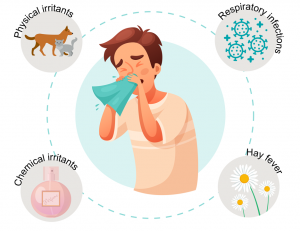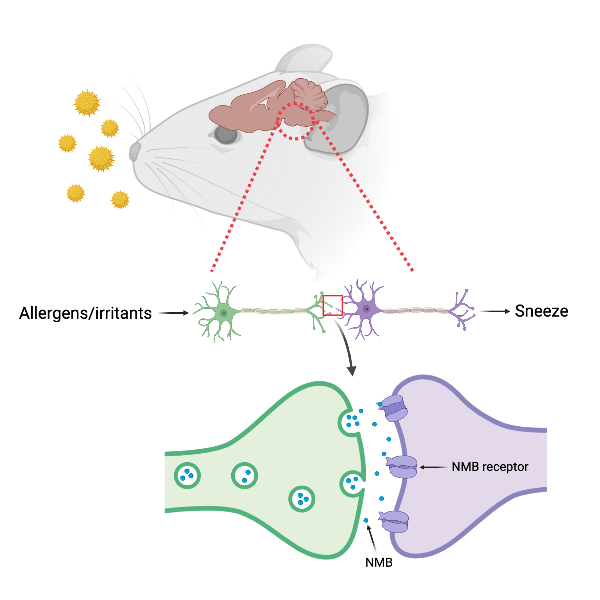
Achoo! Sneezing mice reveal molecular pathway that initiates sneezes
Imagine you are standing in your kitchen cooking up a big pot of chili. You taste your culinary masterpiece and realize it could use a little more pepper. As you’re shaking the pepper into the pot, some of the pepper particles float up towards your nose. Next thing you know, your eyes are watering and your nose is itchy. You close your eyes, take a deep, sharp inhale and then ACHOO!
Others of us are seasonal allergy sufferers who unfortunately experience the helpless feeling of a sneeze more regularly. While allergy medicine does help alleviate allergy-induced sneezing to a certain degree, there is a need for other interventions to curtail chronic sneezing. Until recently, there was little known about the actual molecular process of sneezing to help create new therapeutics.
Why do we sneeze?
 Sneezing is a basic respiratory reflex that rids the airway of irritants and pathogens. Many sneezes are caused by allergens like dust or dander entering the nose or throat. Illnesses like the flu or the common cold that irritate the mucosal lining of the nose can also cause sneezing. Sneezes can also be triggered by exposure to chemical or environmental irritants like smoke, dry air, or perfume.
Sneezing is a basic respiratory reflex that rids the airway of irritants and pathogens. Many sneezes are caused by allergens like dust or dander entering the nose or throat. Illnesses like the flu or the common cold that irritate the mucosal lining of the nose can also cause sneezing. Sneezes can also be triggered by exposure to chemical or environmental irritants like smoke, dry air, or perfume.
While sneezing is designed to be a defense mechanism against damage to the airway, for people with chronic allergies or infections sneezing can severely impact quality of life and productivity. Sneezing represents the most forceful and common mechanism to spread infectious droplets. Studies show that a single sneeze can create upward of 40,000 virus-containing droplets that reach a radius of seven to eight meters and can suspend in the air for up to ten minutes.
In most cases, the reason behind the sneeze is well-known. However, it is less clear how sneezing occurs. Scientists know which part of the brain is active during sneezing but know little about how the sneeze reflex works on a cellular and molecular level. In a recently published study, a team of scientists discovered a neural pathway that seems to lead to sneezing in mice.
Sensory neural pathways
Before we dive into the sneezing pathway, we should briefly discuss how our nervous system keeps us in touch with our environment. Let’s say you touch something hot. Sensory receptors on cells in your skin detect the change in temperature and cause the cell to produce an electrical signal that travels through a neuron.
Neurons are specialized cells that transmit chemical and electrical signals to the brain. A specialized type of neuron called a sensory neuron converts external stimuli from the environment into corresponding internal signals. When the electrical signal reaches the end of the neuron, it causes the release of a signaling molecule called a neurotransmitter.
The neurotransmitter diffuses across the short distance between two neurons and binds to a receptor protein on the target neuron. When the neurotransmitter binds to the receptor, the cell membrane of the target neuron changes its electrical state and a new electrical signal begins. The chain reaction of neurons sending signals to another neuron eventually reaches the appropriate part of the brain which sends a signal to your body to move your muscles and remove your hand from the hot object.
Scientists discover molecular pathway that initiates sneezes
In order to study how invaders in our airways trigger the neural pathway of sneezing, the team needed an experimental model of sneezing. Historically, sneezing models used anesthetized animals that could not make real sneezes. In the old models, other characteristics of sneezing like diaphragm movement were measured instead of actual sneezing.
Scientists developed a new model to study real sneezes by exposing mice to aerosolized histamine (an allergen) and capsaicin (a chemical that gives spicy peppers their burn), which are both known to cause humans to sneeze. They monitored the mice for audible signs of sneezing and also measured muscle movements in the mice. Both histamine and capsaicin induced sneezing in the mice.
To determine the neural pathway that induces sneezing, the team turned their attention to sensory neurons that express a receptor called Trpv1. If Trpv1 sounds familiar to you, that is because the Nobel Prize in Physiology or Medicine was recently awarded to David Julius and Ardem Parapoutian for their discovery of Trpv1 and other sensory receptors. Both capsaicin and histamine can activate Trpv1 and induce a neural signal.
In the case of sneezing, Trpv1+ sensory neurons in the mouse’s nose produce a signaling molecule called neuromedin B (NMB). NMB binds to neurons in a region of the brainstem called the ventromedial spinal trigeminal nucleus (SpV), which is known to be active during sneezing. SpV neurons send electrical signals to neurons in another part of the brainstem region that controls exhalation. Triggering the neurons within this region drives the initiation and propagation of a sneeze.
Sneezing is an important mechanism behind the community spread of many respiratory viruses. It is also disruptive for allergy sufferers. Understanding the mechanism of sneezing opens the door to finding therapies that can help control sneezing. More effective treatments for sneezing could help reduce the spread of infectious diseases and more.

To schedule a media interview with Dr. Neil Lamb or to invite him to speak at an event or conference, please contact Nikki Rohling by email at nrohling@hudsonalpha.org or by phone: Office (256) 327-9417 | Cell (256) 937-8210


